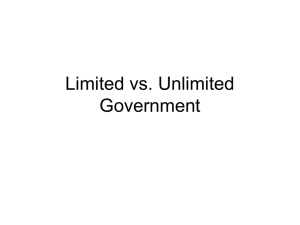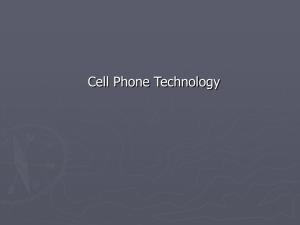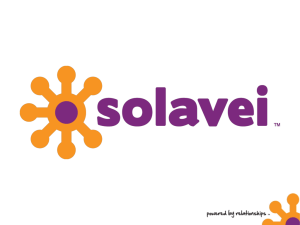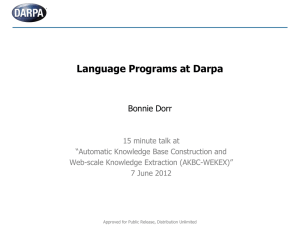Garstang`s Model
advertisement
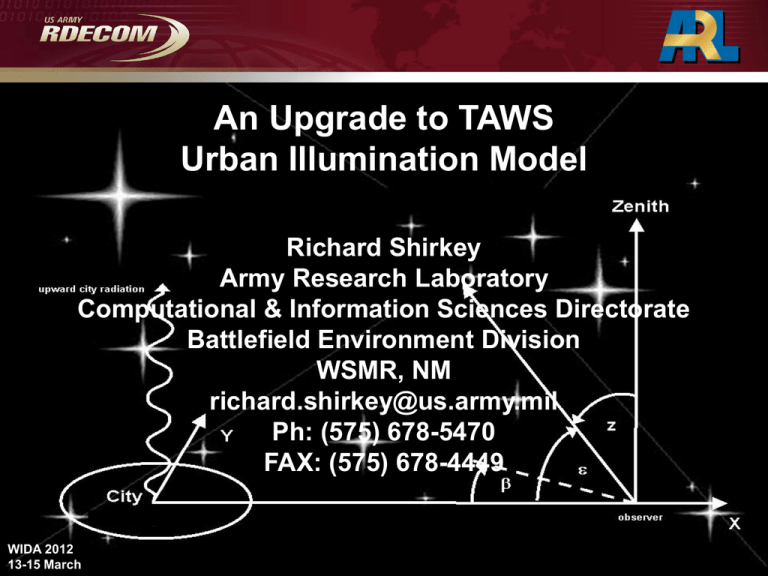
An Upgrade to TAWS
Urban Illumination Model
Richard Shirkey
Army Research Laboratory
Computational & Information Sciences Directorate
Battlefield Environment Division
WSMR, NM
richard.shirkey@us.army.mil
Ph: (575) 678-5470
FAX: (575) 678-4449
WIDA 2012
13-15 March
Approved For Public Release; Distribution Unlimited
OUTLINE
• Purpose
• Beginnings
• Walker
• Treanor
• Objective
• Garstang’s improvements
• AIM v2
• Spectral Radiance
• V&V
2
Approved For Public Release; Distribution Unlimited
Purpose
To provide urban illumination levels
for use in/for
• Simulations
• IWARS
• Target Acquisition
• TAWS
• Night Vision Devices
Approved For Public Release; Distribution Unlimited
Beginnings:
Walker’s Model
Population x 106
Walker took sky brightness measurements of various cities to determine
the distance where the artificial sky brightness was 0.1 mag at the
zenith. From this he constructed the first Population-Distance relation.
3.0
2.0
1.0
20
40
60
80
Distance (miles)
Garstang reformulated Walker’s P-D relation as B = CPD-2.5.
Known as Walker’s law, it is the simplest model for light pollution.
C does not depend on P and D, but depends on factors such as the light emission per head of the population and the reflectivity of the ground
4
Approved For Public Release; Distribution Unlimited
100
Beginnings:
Treanor’s Model
Treanor proposed a simple model for scattering along the
direct beam (TZ) by restricting scattering to a small angle
m. This restricts scattering to the particles which are
contained within the figure of revolution generated by
rotating the arc TQZ about TZ.
This scattered light then
undergoes a final
scattering at Z into the
observer’s LOS.
when
5
' > m scattering is not considered
Approved For Public Release; Distribution Unlimited
Objective
criterion
• A quick running model that accurately portrays both
broadband and spectral illumination received from
urban sources by an arbitrarily placed observer
• point source
• observer 2.25 x city radius
• extended source
• observer 2.25 x city radius
• internal to the city
• Easily obtainable inputs
• Atmospheric variables
• aerosols
• clouds
: acceptable error
D: distance to source
R: radius of source
E: irradiance
L': radiance
Eex = πL'R 2 / (R 2 + D 2)
Ept = πL'R 2 / D 2
= (Ept – Eex)/Eex = R2/D2
D R -½ ( 20% D 2.25 R)
Approved For Public Release; Distribution Unlimited
Garstang’s Model
Assumptions for Garstang’s model are:
• Flat Earth
• All downward-directed light from
fixtures does not undergo scattering or
absorption wrt the atmosphere
© International Dark-Sky Association
• No interaction with buildings or vegetation
• Aerosol scattering is predominantly in the forward
direction
7
Approved For Public Release; Distribution Unlimited
Garstang’s Model
Garstang further modified Treanor’s model by introducing an
exponential atmosphere and directly relating the atmospheric
molecular content to the aerosol content
Na a = 11.11 Nm m K e-cH
where N is the number density,
is the particle cross section,
H is the height of the city and
K is Garstang’s “clarity factor”.
8
Approved For Public Release; Distribution Unlimited
Garstang’s Model
The city emission function is defined by
I = LP/2 {2G (1-F) cos + 0.554 F 4}
City Emission Function
where I is the upward intensity, F is the
fraction of light that “escapes” the
luminaries shielding in an upward
direction, G is the surface albedo and
is the angle between the upward
normal and an upward light ray.
Cinzano has found that the shape of the
emission function is not important
9
Approved For Public Release; Distribution Unlimited
“Double Scattering”
General Scenario
Final Equations
Brightness
Small Angle Approximation
10
Approved For Public Release; Distribution Unlimited
Garstang’s Model:
Details
Broadband Brightness in Garstang’s model is
represented by
b = Nm R e-cH (dx dy / R2) du
x
0
Iup S-2 EFxq EFqo SAA
{ e-ch (1 + cos2[ + ]) 3/(16)
+ e-ah 11.11 K f( + )}
11
Approved For Public Release; Distribution Unlimited
AIM v2
• Original model tenets maintained
• brightness ~ population
• SSA
• City population data base included
• Cloud effects added
• 8 cloud types
• reflection
• Lighting data base added
• Airglow included
12
Approved For Public Release; Distribution Unlimited
Natural Background Radiation
In the absence of moonlight and artificial light,
the night sky still is not “dark”.
S10 is a bizarre astronomical unit of surface brightness
corresponding to one 10th-magnitude star per square degree
13
Approved For Public Release; Distribution Unlimited
Natural Background Radiation
In general:
Bnsb = 27.78 – 2.5 x log10(Bairglow + Bzodiacal + Bstarlight),
where Bairglow, Bzodiacal, and Bstarlight are functions of the solar
sunspot cycle, the ecliptic latitude, and the galactic latitude
respectively.
It was deemed reasonable to set the value of Bnsb = 17.6 nL
rather than carry out additional computations for only a small
additional contribution to the total night sky brightness
For Denver at a distance of ~70 km the model predicts that
the brightness is ~18 nL.
14
Approved For Public Release; Distribution Unlimited
Cloud Effects
• Transmission through clouds determined using ILLUMA
• 8 cloud types in 3 layers
• High
- clear, thin and thick Ci/Cs
• Medium - clear, As/Ac
• Low
- clear, clear (f/k), Cu/Cb or St/Sc
• allowance for partial cloudiness
• Cloud reflection
• cloud and angle dependent
reflectivity taken from Shaprio
• simple attenuation in upward
and downward paths
• from lowest layer only
15
Approved For Public Release; Distribution Unlimited
AIM Input
• city name, city radius, city altitude, lumens/head
• distance from observer to source, observer altitude,
zenith angle, azimuth angle
• clarity factor, surface albedo, fraction of light in
upward direction
• month, day, year, UTC
• light type percents
• cloud type & cloud amount for layer i, i = 1,3
16
Approved For Public Release; Distribution Unlimited
Validation
Clear Skies
Sky brightness due to Denver as a function
of zenith angle at a distance of 40 km*
Sky brightness due to Denver as a function of
distance for a zenith angle of zero*
* Garstang ‘86
17
Approved For Public Release; Distribution Unlimited
Brightness Distribution
Denver
8.6 km from city center
Zenith = 0
X
Observer
18
Approved For Public Release; Distribution Unlimited
Brightness Distribution
Boulder
Zenith = 65
Azimuth = 180
Distance = 0 km
Boulder
Zenith = 65
Azimuth = 0
Distance = 0 km
X
X
Boulder
Zenith = 65
Azimuth = 45
Distance = 0 km
Boulder
Zenith = 65
Azimuth = 45
Distance = 2 km
X
X marks observer position
19
X
Approved For Public Release; Distribution Unlimited
Spectral Radiant Energy
20
Approved For Public Release; Distribution Unlimited
Spectral Radiant Energy
Broadband illumination is broken into spectral components
dependant on the City’s light types and amounts
Approach
Determine
1) Light types
2) Percent contribution
3) Spectral radiance values for each light type
21
Approved For Public Release; Distribution Unlimited
Spectral Radiant Energy
Light Types and their default percentages*
Light Type
Clear Mercury
Default Value (%)
Pi
20.2
Low Pressure Sodium
0
High Pressure Sodium
77.9
Metal Halide
1.9
white LED
0
Standard Fluorescent
0
Incandescent
0
Liquid Kerosene
0
Pressurized Propane
0
* El Paso Electric Co.
22
Approved For Public Release; Distribution Unlimited
Light Type Spectra
(1 nm resolution)
Mercury Vapor
Metal Halide
Incandescent
23
HPS
LPS
Fluorescent
LED
Kerosene
Propane
Approved For Public Release; Distribution Unlimited
j 1
Li (bin) li
Spectral Radiant Energy
Technique
j
For Light Type i
1) Identify total contribution over wavelength band
S1 to S2
S1
Ltotal
S2
L
S
S2
wavelength
band under
consideration
HPS
1
2) Bin contribution
LJth bin
J 1
L
J
24
Approved For Public Release; Distribution Unlimited
HPS
j 1
Li (bin) li
j
Spectral Radiant Energy
Technique
3) Fractional radiance
Lbin
Li
Pi
Ltotal
4) Final spectral radiance
sum over light type
N
B B Li
i 1
25
Approved For Public Release; Distribution Unlimited
Spectral Radiance
Spectrum of
Los Angles
Zenith view
Courtesy of Dr. Martin Aubé
http://lightpollution.no-ip.org/~lightpol/data_usage.html
Approved For Public Release; Distribution Unlimited
Aubé
AIM v2
10% Clear Mercury
5% LPS
55% HPS
20% Metal Halide
10% Incandescent
No Airglow
27
Aubé
AIM v2
10% Clear Mercury
5% LPS
55% HPS
20% Metal Halide
10% Incandescent
SAB + Airglow
Note increase in
background level
28
V&V
Night Illumination Test Evaluation
(NITE)
A Joint Undertaking with the UK Met Office
29
Approved For Public Release; Distribution Unlimited
NITE: Location
x
30
Approved For Public Release; Distribution Unlimited
Night Illumination Test Evaluation
(NITE)
31
Approved For Public Release; Distribution Unlimited
Night Illumination Test Evaluation
(NITE)
x
32
Approved For Public Release; Distribution Unlimited
Night Illumination Test Evaluation
(NITE)
x
33
Approved For Public Release; Distribution Unlimited
NITE: Instrumentation
Microtops Sunphotometer
5 channel hand-held sunphotometer for
measuring aerosol optical thickness easily,
accurately and dependably.
34
Approved For Public Release; Distribution Unlimited
NITE: Instrumentation
LMT
Hoffman
Albedo stand
All-Sky camera
first day out (brrr)
35
Approved For Public Release; Distribution Unlimited
NITE: Meteorology
• Met data
• WSMR04
• Holloman AFB
• mesonetwest.utah.edu
Approved For Public Release; Distribution Unlimited
NITE: Satellite Pictures
37
Approved For Public Release; Distribution Unlimited
What’s Next?
• Variable turbid atmosphere
• add assortment of aerosol types
• Inclusion of horizontal single scattering effects
• zenith angles > 80 produce dubious results
• City reflection from partially cloudy skies
• reflection only allowed from lowest layer
• Terrain/Vegetation blocking
• NITE data reduction for V&V
38
Approved For Public Release; Distribution Unlimited
Acknowledgements
Warren Lewis* (for suggesting NITE)
Damian Wilson* (for tolerating numerous snafus)
Jeff Passner§ (for satellite pics)
Ed Creegan§ (for setup and data acquisition)
Will Lee-Rodgers* (for just about everything else)
* UKMO
§ ARL
39
Approved For Public Release; Distribution Unlimited
?
40
Approved For Public Release; Distribution Unlimited

